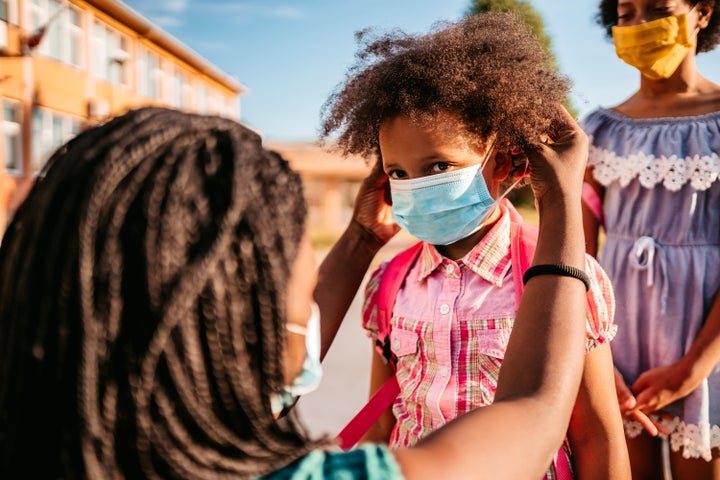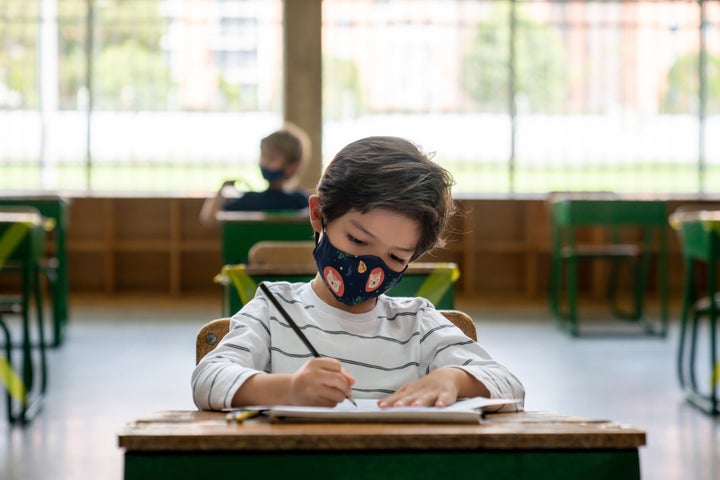
For a period of time earlier this summer, parents around the United States breathed a collective sigh of relief as coronavirus cases fell and life felt increasingly normal(ish).
Then the delta variant hit, spreading quickly among the unvaccinated, and because that is a group that includes children under the age of 12, who aren’t yet eligible for shots, kids have been hit particularly hard.
Children now make up nearly 1 in 5 cases of COVID-19. Hospitalizations and deaths, thankfully, remain really rare, but many parents certainly aren’t feeling confident the way they were just a month or so ago.
So HuffPost Parents reached out to several experts to discuss what it takes to keep kids safe from COVID-19 now and how the delta variant has changed things.
Now is the time to take a hard look at unnecessary indoor activities
As a general principle, “minimizing indoor activities is an excellent idea,” Rick Malley, a senior physician with the division of infectious diseases at Boston Children’s Hospital, told HuffPost.
It’s been estimated that less than 1 percent of COVID-19 transmission occurs outdoors, although experts are actively studying the impact that delta has had on the frequency of outdoor transmission. (Notably, not all outdoor events are created equal. Recent outbreaks have been tied to outdoor music festivals, where groups of people spend a fair amount of time close together in crowds and huddle together in food lines, while waiting for the bathroom, etc.)
Every family will make different calculations about what constitutes an “unnecessary” indoor activity or interaction, though public health groups have been very clear that school does not fall into that category.
The Centers for Disease Control and Prevention and American Academy of Pediatrics have stated unequivocally that, at this moment, the potential risks of in-person learning pale in comparison to the emotional and educational benefits.
But other indoor activities that might have felt pretty darn safe a month or two ago are definitely riskier now because delta is so contagious and because there’s now some evidence that even people who are fully vaccinated can transmit the virus. Experts urge parents to monitor what local transmission is like near them and plan their activities accordingly.
“Go to restaurants that have outdoor seating,” suggested Malley. “Movie theaters may not be the best choice if [you’re] living in an area where viral transmission is high.” However, public transportation — with masks — is “reasonable,” he said.
“Parents should weigh their risk tolerance with the actual risk based on the planned activity, their local disease activity, and their comfort level,” said Joshua Schaffzin, director of Infection Prevention and Control at Cincinnati Children’s. Basically, more of what we’ve already been doing for about 18 long months now.

Wearing masks indoors and in crowded spaces is more important than ever
Whenever children over the age of 2 are in indoor public settings they should absolutely be wearing masks. Mask mandates in schools have become politicized, but children are in many ways even more experienced mask wearers than adults.
“Kids can tolerate masking more than adults give them credit for,” Schaffzin said. “They will likely be comfortable wearing masks in indoor venues when they are not eating.”
That extends to outdoor settings where people are spending a lot of time in close contact in crowds.
“If you’re going to places that are crowded, kids should be masked if they’re not vaccinated,” said Karen Ann Ravin, chief of infectious diseases with Nemours Children’s Health System. Again, “crowded” isn’t an exact term, but it may be helpful to keep in mind that the CDC still recommends that schools maintain at least 3 feet of physical distance between children.
But double masking isn’t necessary right now, even with the more contagious delta variant circulating. In fact, it might do more harm than good.
“Having two masks on at any one time could result in kids removing both or neglecting to wear either, which defeats the purpose,” Malley said. Instead, focus on getting your child into a mask that covers their nose and chin and that is comfortable to wear.
“Having children be willing to wear a mask indoors and be comfortable seems more important than aiming for the highest level of protection,” Malley said.
‘Cocooning’ should be a part of your prevention strategy
The basic measures that help keep kids healthy now really are the same ones that have worked since the start of the pandemic: masking, distance, hand hygiene and ventilation.
But parents do have another strategy available to them now, which is making sure that everyone in their household (and ideally anyone who spends a lot of time with their child) who is eligible to get vaccinated is, indeed, fully vaccinated.
“Right now kids under age 12 aren’t eligible, although we’re hoping in early fall to get [emergency use authorization] approval for that age group, so that will be a wonderful thing when it comes. Until then, people can make sure that anybody who is around their kid is vaccinated,” said Ravin.
“We call that ‘cocooning,’ when people around the child are vaccinated if the child can’t be,” she added. “It gives them a protective layer.”
Even though emerging evidence does suggest that fully vaccinated people infected with the delta variant can pass along the virus, they’re much less likely to get infected in the first place, and some new research suggests they’re also likely to be infectious for a shorter period of time.

Know the symptoms of delta, and plan to get kids tested
At this point, the symptoms associated with the delta variant in children are pretty much the same as they have been all along: fever, cough, congestion, gastrointestinal (GI) problems, and a loss of taste or smell. Some experts have noted that kids, in general, tend to have more GI symptoms than adults. And the delta variant might be particularly likely to cause GI problems, although that is all anecdotal at this point.
The challenge for parents is that it is impossible to know whether a child is, say, sniffling and coughing because they have COVID-19 or if they’re sniffling and coughing because they have a cold. So parents and caregivers should plan to get children tested when those symptoms pop up, as they are more likely to do as the school year progresses and children spend more time together.
“I absolutely would get kids tested,” James Schneider, chief of pediatric critical care at Cohen Children’s Medical Center in New Hyde Park, New York, previously told HuffPost. “There’s no downside to doing it.”
Of course, that does mean parents may end up taking their child to a doctor or getting them a test for something that’s ultimately not COVID-19. But as ever, families are all in this together, and those are the kinds of important measures that not only help keep your own child safe and healthy, but others as well.
Experts are still learning about COVID-19. The information in this story is what was known or available as of publication, but guidance can change as scientists discover more about the virus. Please check the Centers for Disease Control and Prevention for the most updated recommendations.